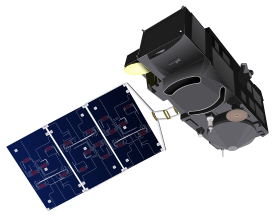
Summary
Sentinel-3A is a European Space Agency Earth observation satellite dedicated to oceanography which launched on 16 February 2016.[5] It was built as a part of the Copernicus Programme, and is the first of four planned Sentinel-3 satellites. Its sister satellite, Sentinel-3B, launched on 25 April 2018. After completing initial commissioning, each satellite was handed over to EUMETSAT for the routine operations phase of the mission. Two recurrent satellites - Sentinel-3C and Sentinel-3D - will follow in approximately 2024 and 2028 respectively to ensure continuity of the Sentinel-3 mission.
 Vector drawing of the Sentinel-3 | |||||||||||||||||
| Mission type | Earth observation | ||||||||||||||||
|---|---|---|---|---|---|---|---|---|---|---|---|---|---|---|---|---|---|
| Operator | ESA · EUMETSAT | ||||||||||||||||
| COSPAR ID | 2016-011A | ||||||||||||||||
| SATCAT no. | 41335 | ||||||||||||||||
| Website | Sentinel-3 (ESA) | ||||||||||||||||
| Mission duration | Planned: 7 years[1] Elapsed: 8 years, 1 month, 23 days | ||||||||||||||||
| Spacecraft properties | |||||||||||||||||
| Spacecraft type | Sentinel-3 | ||||||||||||||||
| Bus | Prima | ||||||||||||||||
| Manufacturer | Thales Alenia Space[2] | ||||||||||||||||
| Launch mass | 1,250 kg (2,760 lb)[3] | ||||||||||||||||
| Dry mass | 1,150 kg (2,540 lb)[4] | ||||||||||||||||
| Dimensions | 3.9 × 2.2 × 2.2 m (12.8 × 7.2 × 7.2 ft)[3] | ||||||||||||||||
| Power | 2,300 watts[3] | ||||||||||||||||
| Start of mission | |||||||||||||||||
| Launch date | 16 February 2016, 17:57 UTC[5] | ||||||||||||||||
| Rocket | Rokot | ||||||||||||||||
| Launch site | Plesetsk Cosmodrome, Site 133 | ||||||||||||||||
| Contractor | Eurockot Launch Services | ||||||||||||||||
| Orbital parameters | |||||||||||||||||
| Reference system | Geocentric | ||||||||||||||||
| Regime | Sun-synchronous | ||||||||||||||||
| Semi-major axis | 7,182.47 km (4,462.98 mi) | ||||||||||||||||
| Eccentricity | 0.000309 | ||||||||||||||||
| Perigee altitude | 802.12 km (498.41 mi) | ||||||||||||||||
| Apogee altitude | 806.56 km (501.17 mi) | ||||||||||||||||
| Inclination | 98.62° | ||||||||||||||||
| Period | 100.97 min | ||||||||||||||||
| RAAN | 117.18° | ||||||||||||||||
| Argument of perigee | 86.80° | ||||||||||||||||
| Mean motion | 14.26 rev/day | ||||||||||||||||
| Repeat interval | 27 days[6] | ||||||||||||||||
| Epoch | 17 February 2016, 18:53:04 UTC[7] | ||||||||||||||||
| Transponders | |||||||||||||||||
| Band | S band (TT&C support) X band (science data) | ||||||||||||||||
| Bandwidth | S band: 64 kbit/s uplink, 1 Mbit/s downlink X band: 2 × 280 Mbit/s[1] | ||||||||||||||||
| |||||||||||||||||
Mission history edit
In October 2015, the Sentinel-3A launch was planned for December 2015,[8] but delays in transportation from Cannes to the Plesetsk Cosmodrome postponed the launch to January 2016.[9] The spacecraft arrived at Talagi Airport aboard an Antonov An-124 on 28 November.[10][11] By 17 December, Sentinel-3A completed pre-launch testing and was placed into storage for the Christmas break, lasting until 11 January 2016.[12] After the break, launch was scheduled for 4 February,[13] but while the spacecraft was being fuelled for launch, Khrunichev Space Center in Moscow determined that the launch pad needed to be recertified, resulting in a further delay.[14] Launch was eventually rescheduled for 16 February.[15]
Launch edit
Sentinel-3A was successfully launched on 16 February 2016 at 17:57 UTC from the Plesetsk Cosmodrome aboard a Rokot launch vehicle. The Briz-KM upper stage fired twice to insert the spacecraft into its intended 815 km (506 mi) orbit, first at 5 minutes and then at 75 minutes after launch. Spacecraft separation occurred at 79 minutes after launch, and ground controllers received the first communication from the vehicle at 92 minutes.[5][16]
Operations edit
The first instrument switched on was OLCI. It made its first picture on 29 February 2016, capturing Svalbard island along with a part of the arctic ice pack near solar terminator.[17]
See also edit
References edit
- ^ a b "Sentinel-3 › Satellite Description". European Space Agency. Retrieved 30 January 2016.
- ^ "Sentinel-3A arrived at launch site" (Press release). Thales Alenia Space. 2 December 2015. Retrieved 30 January 2016.
- ^ a b c "Copernicus: Sentinel-3". eoPortal. European Space Agency. Retrieved 21 December 2015.
- ^ "Satellite: Sentinel-3A". World Meteorological Organization. Retrieved 17 January 2016.
- ^ a b c Bergin, Chris; Graham, William (16 February 2016). "Russian Rokot launches Sentinel-3A". NASA Spaceflight. Retrieved 16 February 2016.
- ^ "Sentinel-3 › Mission Summary". European Space Agency. Retrieved 30 January 2016.
- ^ "Sentinel 3A - Orbit". Heavens Above. 17 February 2016. Retrieved 17 February 2016.
- ^ "Sentinel-3A shows off". European Space Agency. 15 October 2015. Retrieved 30 January 2016.
- ^ "Sentinel-3A taking final steps to launch". European Space Agency. 3 December 2015. Retrieved 30 January 2016.
- ^ "Safe at the launch site". European Space Agency. 4 December 2015. Retrieved 30 January 2016.
- ^ "Sentinel-3A Launch Campaign Commenced". Eurockot Launch Services. 12 December 2015. Retrieved 30 January 2016.
- ^ "Almost time to pack up for Christmas". European Space Agency. 17 December 2015. Retrieved 30 January 2016.
- ^ "Back to Plesetsk and brrrrr... it's cold". European Space Agency. 12 January 2016. Retrieved 30 January 2016.
- ^ "Satellite fuelling on hold". European Space Agency. 21 January 2016. Retrieved 30 January 2016.
- ^ "Sentinel-3A gets new launch date". European Space Agency. 27 January 2016. Retrieved 30 January 2016.
- ^ "Third Sentinel satellite launched for Copernicus". European Space Agency. 16 February 2016. Retrieved 16 February 2016.
- ^ "Just two weeks after launch, the latest Sentinel satellite has offered a taster of what it will provide for the EU's Copernicus programme" (Press release). EUMETSAT. 2 March 2016. Archived from the original on 14 June 2016. Retrieved 2 March 2016.
External links edit
- Sentinel-3 program website by ESA
- Sentinel-3 website by the Copernicus Programme
- Real-time orbital tracking - uphere.space


